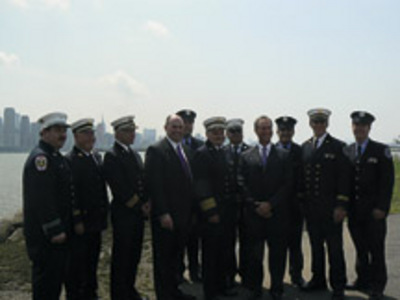More than six months have passed since U.S. Airways Flight 1549 made an emergency landing in the Hudson River, but none of the passengers have forgotten the chilling temperatures and the first responders who saved them from the icy waters.
Dave Sanderson, who was the last passenger out of the rear of the Airbus 320, and Barry Leonard, one of the first out of the front exit of the plane, met after being rescued from the 20 degree waters of the Hudson River on Jan. 15.
Talking that day in Palisades Medical Center’s emergency room, they realized that they only lived a mile away from each other in Charlotte, N.C.
For months, they discussed the fact that while Captain Chesley “Sully” Sullenberger and his crew were lauded for their work landing the plane, many of the first responders in New Jersey who had brought 57 victims to a triage center set up at NY Waterway Ferry Station in Weehawken and Palisades Medical Center in North Bergen had not been thanked enough.
So they held a luncheon last Tuesday on the shores of the Hudson River at Palisades Medical Center, paid for with their own funds, to show their appreciation.
The U.S. Coast Guard, North Hudson Regional Fire and Rescue (NHRFR), NY Waterway Ferries, American Red Cross, Weehawken Volunteer First Aid, West New York E.M.S., North Bergen E.M.S., the Hudson County Office of Emergency Management, the New Jersey E.M.S. Task Force, the Weehawken Police Department, the Guttenberg Police Department, McCabe Ambulance, and the Harrison Fire Department all had members present.
Doctors and nurses who had cared for victims suffering from hypothermia and other injuries were also there to greet a much warmer Sanderson and Leonard.
“I was just talking to one of [the nurses]…she had to put 10 blankets on me and they just kept trying to warm me up,” said Leonard. “I just couldn’t warm up. I was so cold.”
‘Real heroes’
Sanderson said on that fateful flight, he sat four rows behind the left engine that eventually exploded after geese flew into it. He said he knew it was serious when he was able to see the faces of onlookers before the plane crashed into the Hudson.
He said the hit was hard enough to cause all the seats to collapse on impact, but he saw light coming through the window and thought that he had a chance.
He hung onto a life boat, waist deep in freezing water for seven minutes, until a tug boat hit the front of the plane and a wave of water hit his back. That’s when he decided to swim to the closest ferry.
While Leonard was one of the first people out, the lifeboat on his side of the plane did not inflate, and he jumped in and swam until a boat saved him.
They were brought to the triage area and then to the Palisades Medical Center, where they were able to recover from extremely low body temperatures, and for Sanderson, blood pressure that made the doctors believe he was at risk for a heart attack.
Leonard, unable to hold back his emotion Tuesday, said that all of the 155 passengers saved that day were eternally grateful.
“Just seeing some of the nurses is amazing, and I can never thank you enough, Palisades Medical Center,” said Leonard. “I just can’t thank everyone enough … It’s not about Dave or me, it’s about y’all.”
Sanderson said that he believed Sullenberger was correct in saying that while he landed the plane, and the passengers and crew were able to evacuate, the “real heroes were the first responders.”
Nice for a change
Guttenberg Public Safety Director Michael Caliguiro said that he, along with Lt. Joel Magenheimer, Sgt. Vincent Conversano, and Police Officer Jeffrey Lugo, were among the first units there.
He wrapped one of the children in his coat when they reached the Weehawken shore.
Mickey McCabe, the director of McCabe Ambulance and the Hudson County coordinator of Emergency Medical Services, said that after receiving the phone call in January, he had 100 ambulances ready to be mobilized to the scene.
Both McCabe and Caliguiro said that the event showed how departments could efficiently work together.
Firefighters do their jobs without ever expecting appreciation, said NHRFR Chief Brion McEldowney, adding that getting a “pat on the back” was nice for a change.
Weehawken Deputy Chief Jeffrey Fulcher remembered commandeering a ferry boat to get to the plane. The boat acted as a buffer to the Hudson River’s strong currents for other emergency personnel.
“It’s very nice to feel that someone recognized the efforts, especially on the volunteer end of things,” said Fulcher.
NHRFR Co-Director Jeff Welz said the emergency plans established in the area after the 9/11 tragedy worked “probably flawlessly,” and that a large part of that was due to Weehawken-based NY Waterway, who instead of running their normal rush hour commute, began to ferry victims to the shore, just as they’ve done in past emergencies.
“The plane came right behind our boat,” said NY Waterway Captain Manny Liba. “Well, [I thought, ‘We] have to save those people.’ ”
Tricia Tirella may be reached at TriciaT@hudsonreporter.com.
